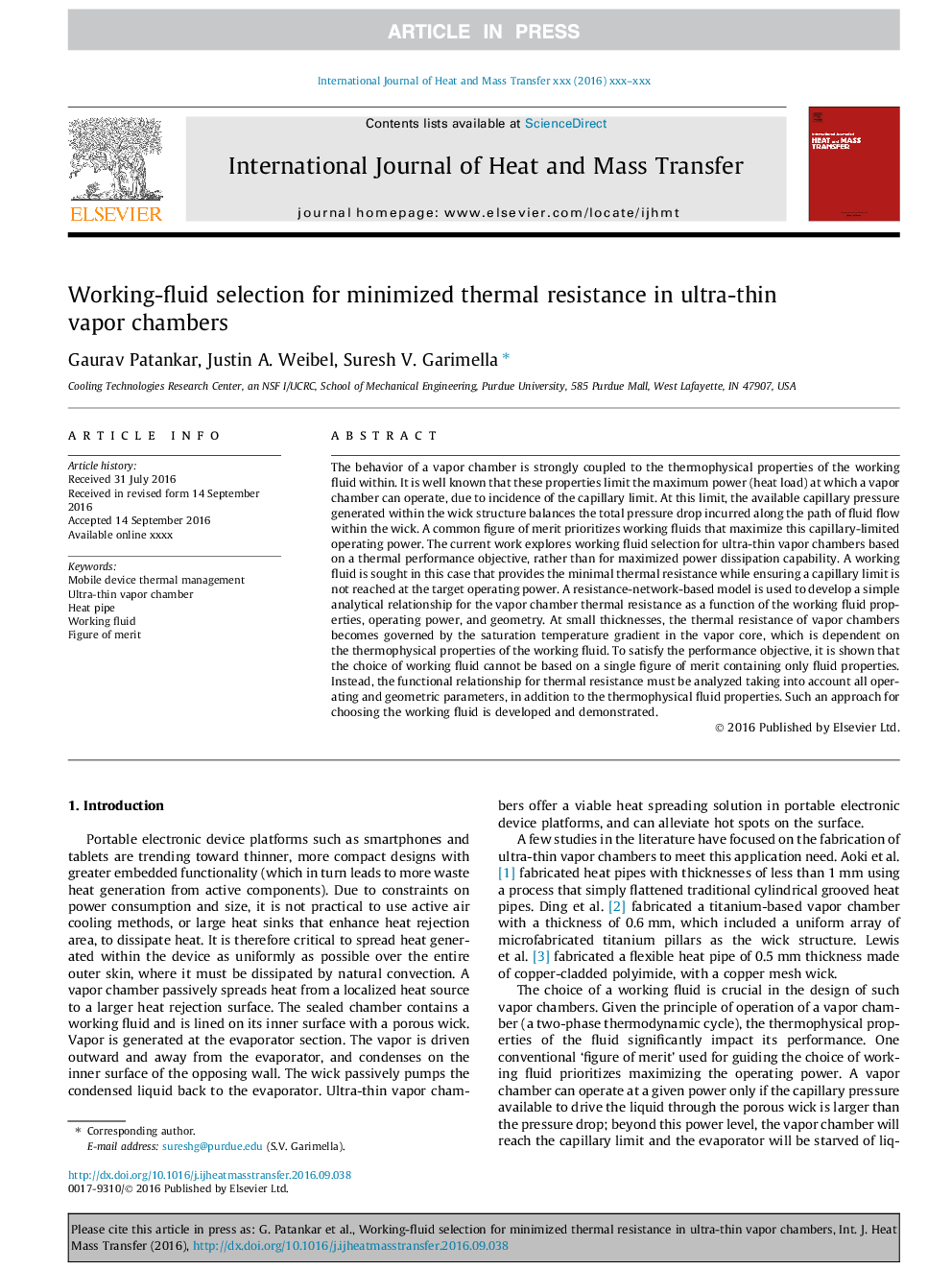| کد مقاله | کد نشریه | سال انتشار | مقاله انگلیسی | نسخه تمام متن |
|---|---|---|---|---|
| 4994794 | 1458036 | 2017 | 7 صفحه PDF | دانلود رایگان |
عنوان انگلیسی مقاله ISI
Working-fluid selection for minimized thermal resistance in ultra-thin vapor chambers
ترجمه فارسی عنوان
انتخاب مایع کار برای مقاومت حرارتی حداقل در اتاق های بخار فوق لایه
دانلود مقاله + سفارش ترجمه
دانلود مقاله ISI انگلیسی
رایگان برای ایرانیان
کلمات کلیدی
مدیریت حرارتی حرارتی، محفظه بخار فوق العاده نازک، لوله حرارتی، مایع کار، معیار شایستگی،
ترجمه چکیده
رفتار یک بخار بخار به شدت به خواص ترموفیزیکی مایع کار در داخل متصل است. به خوبی شناخته شده است که این ویژگی ها حداکثر قدرت (بار گرما) را که در آن بخار بخار می تواند به علت بروز حد مویرگ محدود شود، محدود می کند. در این حد، فشار مویرگی موجود در ساختار ویک، مجموع افت فشار را که در طول مسیر جریان مایع درون جاروب رخ می دهد، تعادل می دهد. یک شایستگی شایسته، مایعات کار را اولویت بندی می کند که حداکثر این توان عملیاتی محدود به مویرگی را افزایش می دهد. کار فعلی، انتخاب مایع کار برای اتاق های بخار نازک بر اساس هدف عملیاتی حرارتی، به جای اینکه به حداکثر توانایی از بین رفتن قدرت، کمک کند. در این مورد یک مایع کار می کند که حداقل مقاومت حرارتی را فراهم می کند در حالی که اطمینان از حد مجاز مویرگی در قدرت عملیاتی هدف نیست. یک مدل مبتنی بر شبکه مقاومتی برای توسعه یک رابطه تحلیلی ساده برای مقاومت حرارتی بخار بخار به عنوان عملکرد خواص مایع کار، نیروی کار و هندسه استفاده می شود. در ضخامت های کوچک، مقاومت حرارتی بخار بخار توسط گرادیان درجه اشباع در هسته بخار، که وابسته به خواص ترموفیزیکی مایع کار می شود، کنترل می شود. برای برآورده کردن هدف عملکرد، نشان داده شده است که انتخاب مایع کار نمی تواند بر اساس یک شایستگی تنها شامل خواص مایع باشد. در عوض، رابطه عملکردی برای مقاومت حرارتی باید با توجه به تمام پارامترهای عملیاتی و هندسی علاوه بر خواص مایع حرارتی نیز مورد تجزیه و تحلیل قرار گیرد. چنین روشی برای انتخاب سیال کار شده توسعه داده شده و نشان داده شده است.
موضوعات مرتبط
مهندسی و علوم پایه
مهندسی شیمی
جریان سیال و فرایندهای انتقال
چکیده انگلیسی
The behavior of a vapor chamber is strongly coupled to the thermophysical properties of the working fluid within. It is well known that these properties limit the maximum power (heat load) at which a vapor chamber can operate, due to incidence of the capillary limit. At this limit, the available capillary pressure generated within the wick structure balances the total pressure drop incurred along the path of fluid flow within the wick. A common figure of merit prioritizes working fluids that maximize this capillary-limited operating power. The current work explores working fluid selection for ultra-thin vapor chambers based on a thermal performance objective, rather than for maximized power dissipation capability. A working fluid is sought in this case that provides the minimal thermal resistance while ensuring a capillary limit is not reached at the target operating power. A resistance-network-based model is used to develop a simple analytical relationship for the vapor chamber thermal resistance as a function of the working fluid properties, operating power, and geometry. At small thicknesses, the thermal resistance of vapor chambers becomes governed by the saturation temperature gradient in the vapor core, which is dependent on the thermophysical properties of the working fluid. To satisfy the performance objective, it is shown that the choice of working fluid cannot be based on a single figure of merit containing only fluid properties. Instead, the functional relationship for thermal resistance must be analyzed taking into account all operating and geometric parameters, in addition to the thermophysical fluid properties. Such an approach for choosing the working fluid is developed and demonstrated.
ناشر
Database: Elsevier - ScienceDirect (ساینس دایرکت)
Journal: International Journal of Heat and Mass Transfer - Volume 106, March 2017, Pages 648-654
Journal: International Journal of Heat and Mass Transfer - Volume 106, March 2017, Pages 648-654
نویسندگان
Gaurav Patankar, Justin A. Weibel, Suresh V. Garimella,
